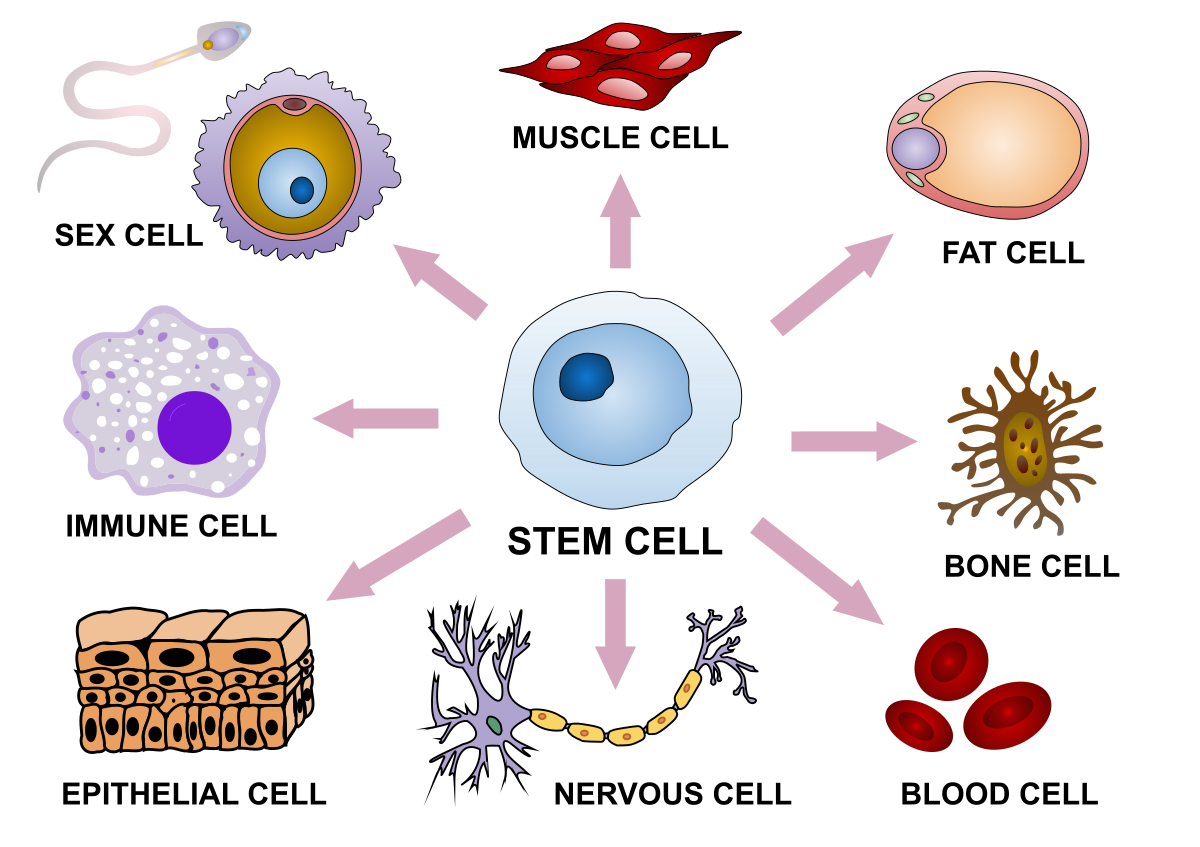
Cell Differentiation and Gene Expression (The Living Cell)
Cell differentiation is the process by which cells of an organism become stably different from each other, both in embryonic development and in mature tissues. Mammals are estimated to have over 200 different cell types. Differentiation is a major component of development; one could say that development consists of (a) cell division, (b) differentiation – producing different cell types – and (c) organizing these cells and their extracellular matrix into tissues and organs. Abnormalities of cell differentiation are involved in cancer and in many birth defects. Cell differentiation involves the synthesis (expression) of specialized “luxury” gene products specific to particular cell types, as opposed to the “house-keeping” genes expressed in all cells. It will be defined further and distinguished from simpler, temporary changes in gene expression (modulation). which are transcription factors. Differentiation occurs in a sequence of steps from one precursor cell type to another (cell lineage). Desired Learning Outcomes White Heavy Check Mark Emoji (U+2705) By the end of this session students should be able to: - Explain the concept of cell differentiation. - Discuss the different levels of cell differentiation. - Describe the properties of stem cells and types. - Explain the two main mechanisms of gene expression regulation in the cell differentiation process. - Enumerate and explain the different applications of the stem cells in the biomedicine field.
-
What is the definition of Cell differentiation?
The process through which a cell undergoes changes in gene expression and gene activity to specialise and take on specific roles in an organism
-
What is the definition of Cell Lineage?
The series of successive cell types leading from the zygote to a particular mature cell type
-
What is the definition of Gene Expression?
Synthesis of the product of a given gene – a protein or a functional RNAs like a tRNA. Involves transcription and (for proteins) translation
-
What is the definition of a Household Gene?
A gene expressed in all or nearly all cell types
-
What is the definition of a Luxury Gene?
A gene expressed in only one or a few cell types
-
What is the definition of a Master gene regulator?
A transcription factor that coordinately regulates many or all of the genes specifically expressed in a particular cell type
-
What is the definition of Pioneer factors?
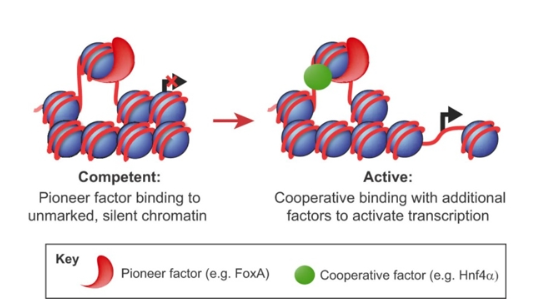
-Transcription factors that can bind condensed or uncondensed chromatin, remodel it and initiate cell-fate and differentiation. They are master regulators. e.g. OCT4, BMP4, SOX2 and NANOG.
- Highly expressed in embryonic stem cells and needed to maintain their pluripotency
- Can activate or inhibit gene expression
a) Histone modificationb) DNA methylation blockage
-
What is the definition of Terminal differentiation?
Production of a mature functional cell type that cannot divide (e.g. neurons, skeletal muscle, granulocytes)
-
What is the definition of a Transit cell?
A cell that is undergoing terminal differentiation towards a functional cell type but is still itself able to divide
-
What is the definition of a Embryonic Stem Cells (ESCs)? And what is its differentiation potential?
Definition: Derived from the inner cell mass of a developing blastocyst (a very early-stage embryo)
Differentiation Potential: Pluripotent, meaning they can differentiate into cells of all three germ layers: ectoderm, mesoderm, and endoderm
-
What is the definition of Induced Pluripotent Stem Cells (iPSCs)? And what is its differentiation potential?
Definition: Created by reprogramming adult somatic cells, such as skin cells, to revert to a pluripotent state
Differentiation Potential: Pluripotent, similar to embryonic stem cells, with the ability to differentiate into various cell types
-
What is the definition of Mesenchymal Stem Cells (MSCs)? And what is its differentiation potential?
Definition: Stromal cells found in bone marrow and other organs.Poorly defined and heterogeneous. They do not self-renew very regularly.
Differentiation Potential: Multipotent, capable of differentiating into cells of mesodermal lineage, such as bone cells, fat cells, and cartilage cells
-
What is the definition of Hematopoietic Stem Cells (HSCs)? And what is its differentiation potential?
Definition: Multipotent stem cells anchored to fibroblast-likeosteoblasts of the marrow of long bones and responsible for the formation of blood cells. Can self-renew
Differentiation Potential: Multipotent, giving rise to various blood cell types, including red blood cells, white blood cells, and platelets.
-
What is the definition of Neural Stem Cells (NSCs)? And what is its differentiation potential?
Definition: Located in the central nervous system, including the brain and spinal cord.
Differentiation Potential: Multipotent, capable of differentiating into neural cells, such as neurons, astrocytes, and oligodendrocytes.
-
What is the definition of Epithelial Stem Cells? And what is its differentiation potential?
Definition: Found in epithelial tissues, including the skin, gastrointestinal tract, and other organs.
Differentiation Potential: Multipotent, contributing to the regeneration of epithelial tissues.
-
What is the definition of Endothelial Progenitor Cells (EPCs)? And what is its differentiation potential?
Definition: Involved in the formation of blood vessels and repair of endothelial lining.
Differentiation Potential: Generally considered multipotent, with the ability to contribute to blood vessel formation.
-
What is the definition of Totipotent Stem Cells?
Have the highest level of differentiation potential. They can give rise to all cell types in the body, as well as the extraembryonic tissues necessary for fetal development, such as the placenta
-
What is the definition of Pluripotent Stem Cells?
Can differentiate into cells of all three germ layers: ectoderm, mesoderm, and endoderm. However, they cannot give rise to the extraembryonic tissues like the placenta
-
What is the definition of Multipotent Stem Cells?
Can differentiate into multiple, but closely related, cell types within a specific tissue or organ. They are more versatile than unipotent cells but still have limitations compared to pluripotent cells
-
What is the definition of Unipotent Stem Cells?
Have the ability to differentiate into only one specific cell type. They are more specialized and committed to a particular lineage
-
What is the definition of Asymmetric Division?
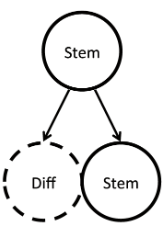
-When a stem cell produces one differentiated cell and one stem cell
-A fate regulator (e.g. polarity protein) distributes unequally in the daughter cells
-
What is the definition of Symmetric Division?
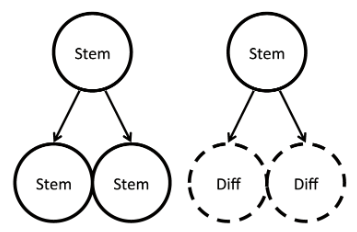
-When a stem cell produces two differentiated cells or two stem cells
-Some cells may divide to give identical daughter stem cells, while other stem cells divide to generate two progenitor cells committed to differentiation
-
What is the function of Multipotent stem cells?
- Their function: dead cells replacement (cell turnover).- Low number in tissues where low rate of cell turnover (adult brain) andabundant in tissues such as intestine epithelium and blood cells
-
Tissue-specific stem cells are maintained in special supportivemicroenvironments called...?
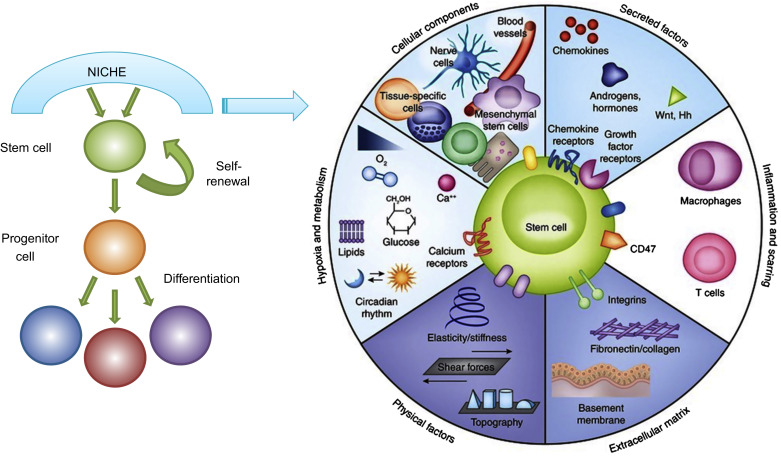
Stem cell niches
-
What are the stem cell niche components (5)? Can you list their roles and functions?
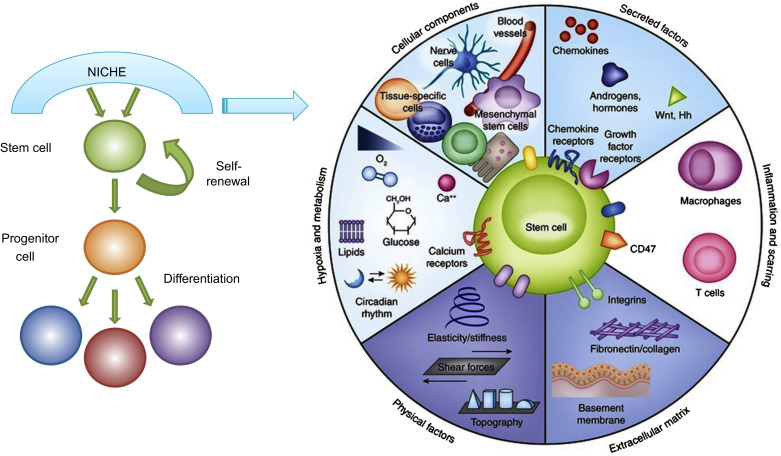
ECM Support:
Function: Guides stem cell behaviour.
Role: Maintains undifferentiated state or guides differentiation
Neighbouring Cells:
Examples: Fibroblasts, nearby cell types.
Role: Contribute via direct cell-to-cell interactions
Soluble Signalling Factors:
Types: Growth factors, cytokines.
Role: Regulate self-renewal and differentiation
Physical Parameters:
Aspects: Shear stress, tissue stiffness, topography.
Impact: Influences stem cell behaviour, e.g., differentiation
Environmental Signals:
Examples: Metabolites, hypoxia, inflammation.
Impact: Affects stem cell maintenance and differentiation
-
How is the transcription profile of each cell analysed?
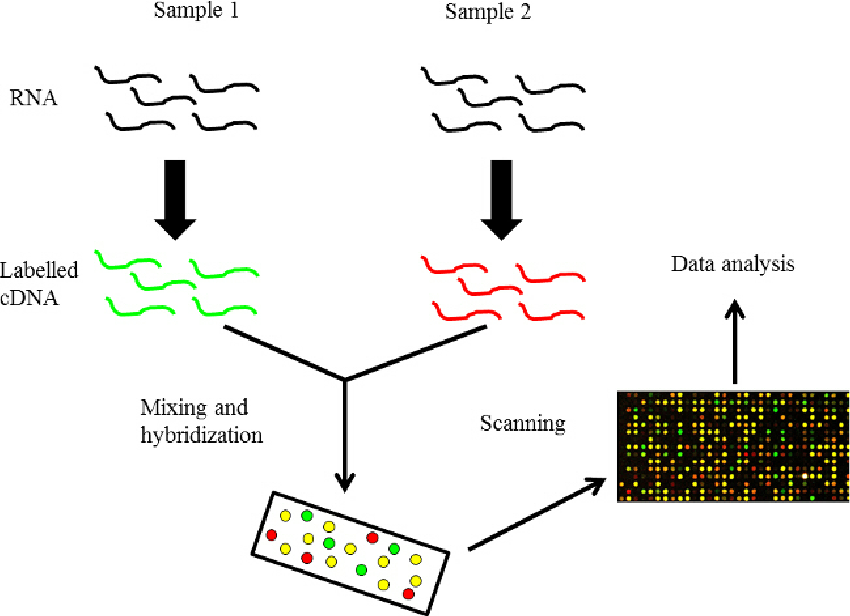
By RNA sequencing and microarrays assays
-
What do transcription factors do?
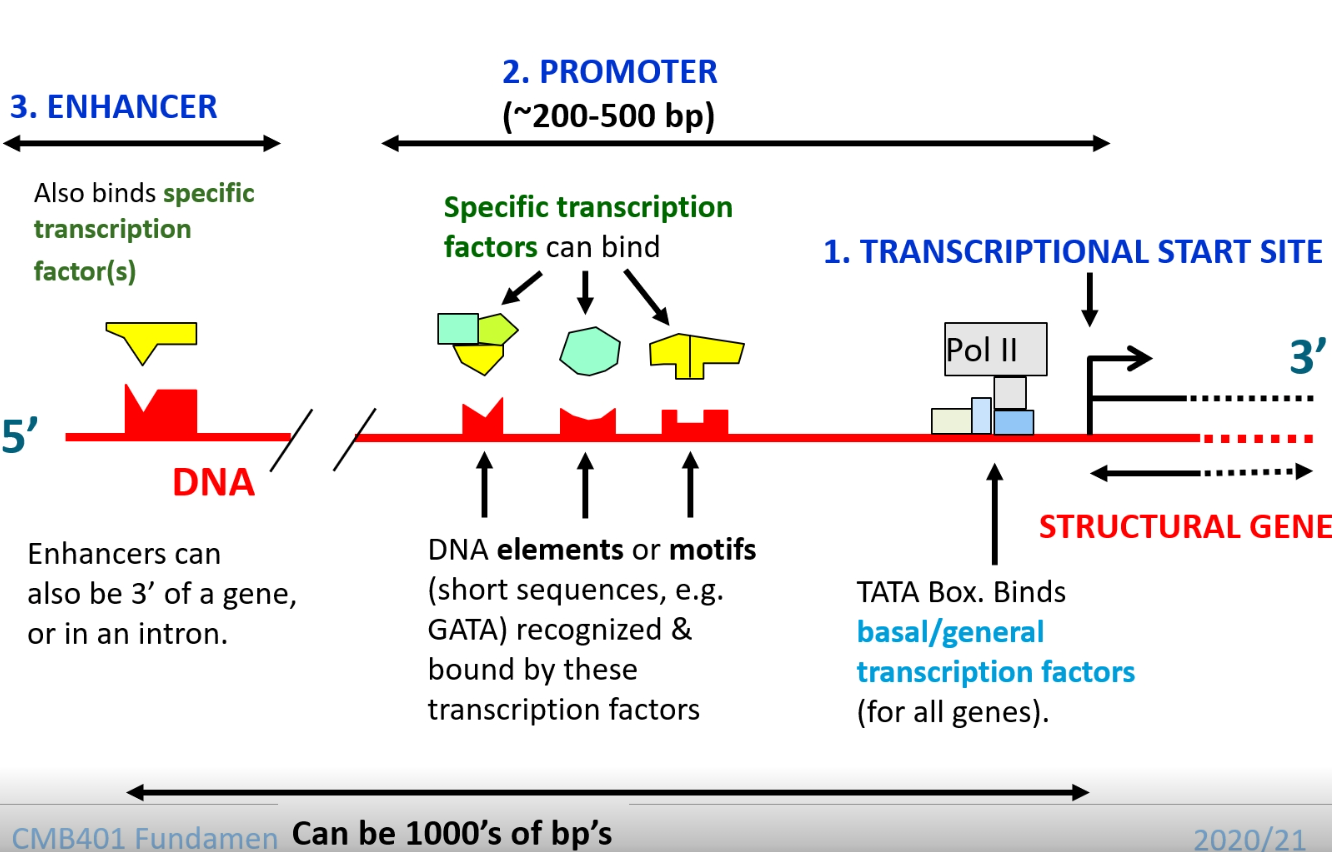
- Transcription factors (TF) bind to regulatory regions of a gene and affect its expression by switching it on/off- Certain TFs are tissues specific, and different TFs are associated with differentiation of stem cells into different tissues.
-
Different genes are activated by different TFs, according to what?
Binding elements (motifs) in their promoters and enhancers
-
What is DNA methylation?
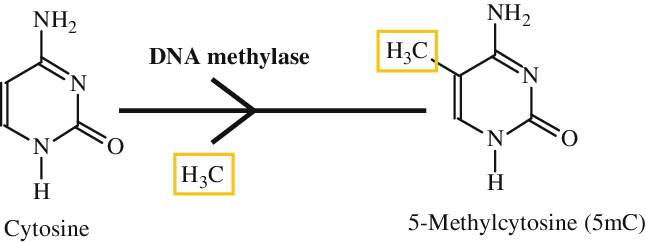
- Epigenetic mechanism that occurs by the addition of a methyl (CH3) group to DNA
- Covalent addition of the methyl group at the 5-carbon of the cytosine ring resulting in 5-methylcytosine (5-mC)
- In somatic cells, 5-mC occurs on CpG sites (cytosine nucleotide is located next to a guanidine nucleotide)
Exception: embryonic stem cells, where is also present in non-CpG regions
-
Do daughter cells remember the methylation pattern?
Yes
-
During differentiation unmethylated CpG (cytosine-guanine pairs) can become methylated by what enzyme?
De novo methyltransferase
-
The methyl group is also copied to the opposite strand (also CpG) by what enzyme?
Maintenance methyltransferase
-
What does DNA methylation generally do?
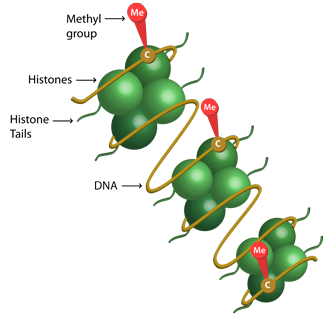
Methylation of a gene (especially its promoter or control sequence) increase folding (heterochromatin) and silencing transcription
-
Applications of stem cells include Somatic Cell Nuclear Transfer (SCNT). What is it?
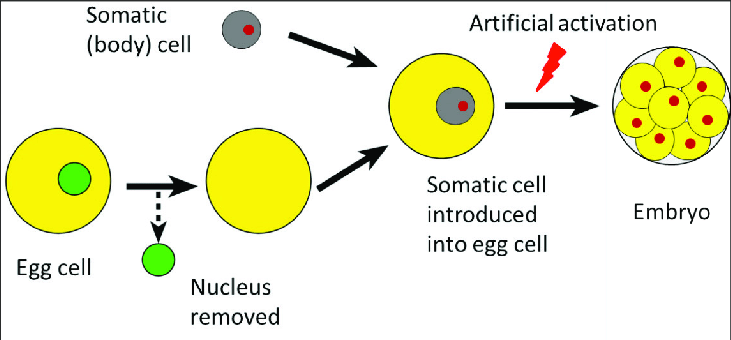
- Artificial removal of the nucleus of a differentiated somatic cell and its placement in a denucleated egg cell- Introduced nucleus is reprogrammed by factors in the egg cytoplasm- The new egg behaves like a zygote (totipotent)
- However, it is challenging and time-consuming
-
Applications of stem cells include Induced Pluripotent Stem Cells (iPSC) What is it?
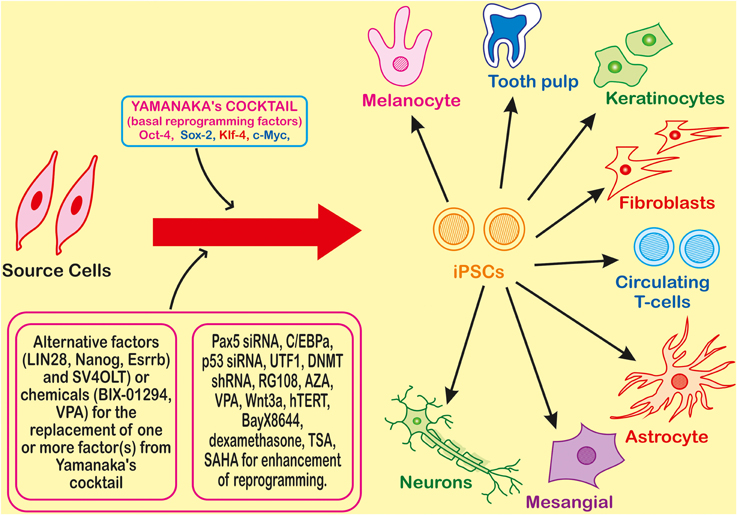
- Pluripotent stem cells artificially produced from somatic cells.- Can potentially produce almost all cells of the organisms.
- Cells are exposed to only four transcription factors (TF): OCT4, SOX2, KLF4 and c-MYC (Yamanaka’s cocktail)
-
What are some uses for Induced Pluripotent Stem Cells (iPSC)? (4)
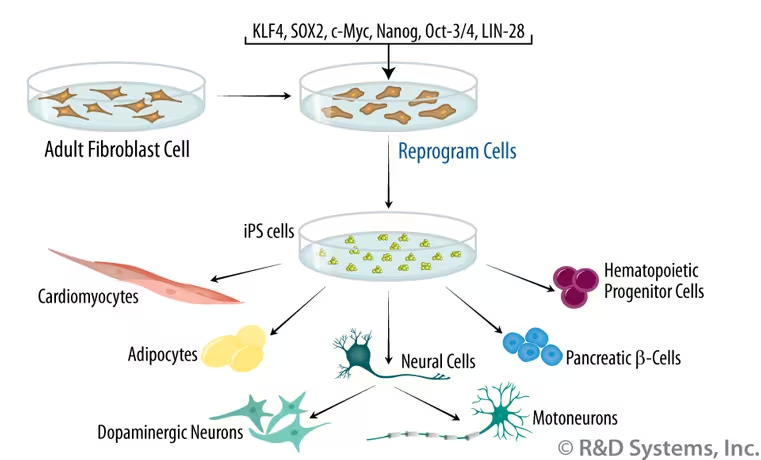
- Gene therapy- Regenerative medicine/celltransplantation- Model disease and drug screening
-
A general summary:
- Cell differentiation is the process through which an immature cell evolves in to a specialised cell
- Stem cells are undifferentiated and unspecialized cells able to renew themselves and differentiate into specialised cells
- Based on the level of cell differentiation, stem cells can be classified as totipotent, pluripotent, multipotent and unipotent.
- Through differential gene expression controlled by transcription factors activity cells differentiate and specialise- Somatic Cell Nuclear Transfer (SCNT) and the production of induced Pluripotent Stem Cells (iPSC) are two of the main applications of the stem cells in the field of the biomedicine

